Indianapolis Public Library
The Indianapolis Public Library (formerly known as the Indianapolis–Marion County Public Library) is the public library system serving the citizens of Marion County, Indiana, United States and its largest city, Indianapolis. The library was founded in 1873 and has grown to include a Central Library building, located adjacent to the Indiana World War Memorial Plaza, and 24 branch libraries spread throughout the county.
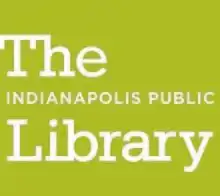 | |
 Central Library, the Indianapolis Public Library's main branch | |
| Established | 1873 |
|---|---|
| Location | Indianapolis, Indiana, United States |
| Branches | 24 |
| Access and use | |
| Circulation | 9,652,945 (2019)[1] |
| Population served | 952,389 (2019) |
| Other information | |
| Budget | $60,087,318 (2019)[1] |
| Director | Jackie Nytes (CEO)[1] |
| Staff | 600+[2] |
| Website | indypl.org |
| Map | |

| |
History
.jpg.webp)
.jpg.webp)
The Indianapolis Public Library system attributes its beginnings to a Thanksgiving Day, 1868, sermon by Reverend Hanford A. Edson, pastor of the Memorial Presbyterian Church (which would later become Second Presbyterian Church), who issued a plea for a free public library in Indianapolis. As a result, 113 residents formed the Indianapolis Library Association on March 18, 1869. In 1870, under the leadership of the superintendent of public schools, Abram C. Shortridge, citizens drafted a revision of Indiana school law to provide public libraries controlled by a board of school commissioners. The bill passed the Indiana General Assembly, allowing school boards to levy taxes for the purpose of establishing and maintaining public libraries.[3]
In 1872, the public library committee of the school board hired Cincinnati librarian William Frederick Poole to begin a collection for the new library and appointed Charles Evans as the first librarian. Indianapolis' first public library opened in one room of the Indianapolis High School building at the northeast corner of Pennsylvania and Michigan streets on April 8, 1873.[4] Upon opening, the library’s collection numbered 13,000 volumes and registered 500 borrowers. By the end of its first full year of operation, some 3,000 patrons borrowed more than 100,000 books.[4] Later, as the need for more space grew, the library moved to the Sentinel Building on Monument Circle (1876–1880) and the Alvord House at Pennsylvania and Ohio streets (1880–1893).[3]
Evans served as librarian until 1878, and again from 1889 to 1892. Evans' successors were Albert B. Yohn (1878–1879), Arthur W. Tyler (1879–1883), and William deM. Hooper (1883–1889). Eliza G. Browning succeeded Evans in his second tenure, holding the position from 1892 to 1917. During her leadership, the library moved to the first building constructed solely for its purpose, located on the southwest corner of Ohio and Meridian streets in 1893 and opened its first library branch opened in 1906 on Clifton Street in the Riverside neighborhood.[4] Between 1910 and 1914, another five library branches were built with $120,000 donated by Andrew Carnegie.[4] As of 2020, two of these libraries—East Washington and Spades Park—are still active branches. Prior to her resignation, Browning initiated work on a new Central Library located partially on land donated by Hoosier poet James Whitcomb Riley in 1911.[3][4]
Charles E. Rush succeeded Browning, serving as librarian from 1917 until 1927. His successors were Luther L. Dickerson (1927–1944) and Marian McFadden (1944–1955). During this period, eight new branch libraries were opened, and the system’s collections expanded to include films, newspapers on microfilm, and phonorecords. Additionally, bookmobile service began in 1952.[3]
Harold J. Sander, who served as director from 1956 to 1971, presided over the opening of ten new branch libraries and undertook a reorganization of the Central Library in 1960 that departmentalized services. Prior to 1966, the library system served only those areas of the city under the jurisdiction of Indianapolis Public Schools, leaving more than 200,000 Marion County residents without access to free public library services. From 1966 to 1968, the newly formed Marion County Public Library Board contracted with the Indianapolis Public Library for service to county residents. In 1968, the Indianapolis Board of School Commissioners relinquished responsibility for library service, allowing the city and county library systems to merge. This established the Indianapolis–Marion County Public Library as a municipal corporation serving all Marion County residents, with the exception of Beech Grove and Speedway.[3]
Raymond E. Gnat succeeded Sander as library director in 1972. Essential library services were computerized between 1982 and 1991. By the early-1990s, the public library system encompassed 21 branches and three bookmobiles. In 1991, some seven million items were circulated among 470,000 registered borrowers and 3.4 million inquiries were answered. At this time, the library collection contained nearly 1.7 million materials staffed by 410 full-time employees.[3] Ed Szynaka served as director from 1994 until 2003, presiding over capital improvements to eight branch libraries, including the relocation of the Broad Ripple Branch to the Glendale Town Center.[5] The Glendale Branch opened in 2000 as the first full-service library at a major shopping center in the U.S.[6] Laura Johnston served in an interim role from 2003 to 2004 until the appointment of Linda Mielke, who served from 2004 until 2007.[5] She was succeeded by Laura Bramble.[5] Following the Great Recession and a successful state ballot measure to cap property taxes in 2008, the Indianapolis Public Library faced a budget shortfall of $4 million in 2010.[7][8] After considering closing six branches, officials decided to reduce branch hours by 26 percent, layoff 37 employees, and increase fines.[5][9][10][11]
Jackie Nytes has been the Indianapolis Public Library chief executive officer since 2012.[12][13] The library reported 4.3 million patron visits in 2013 and circulation of 15.9 million items.[14] In 2014, the library board received approval from the Indianapolis City-County Council to begin issuing $58.5 million in bonds to renovate and relocate existing branches and construct new ones.[14][15] In April 2016, the boards of the Indianapolis and the Beech Grove public libraries voted to merge, with the Beech Grove library becoming the 23rd branch library of the Indianapolis system on June 1, 2016.[16]
Central Library
Central Library (Indianapolis–Marion County Public Library) | |
 Front of Central Library from the American Legion Mall | |
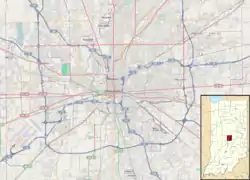   | |
| Location | 40 E. St. Clair St., Indianapolis, Indiana |
|---|---|
| Coordinates | 39°46′42″N 86°9′24″W |
| Area | 1 acre (0.40 ha) |
| Built | 1917 |
| Architect | Paul Cret; Borie and Medary Zantzinger |
| NRHP reference No. | 75000045[17] |
| Added to NRHP | August 28, 1975 |

The Central Library building was designed by Philadelphia-based architect Paul Philippe Cret (with Zantzinger, Borie and Medary).[18] The original Central Library building was constructed in Greek Doric style architecture, faced with Indiana limestone on a Vermont marble base. Central Library opened to the public on October 8, 1917.[3]
Central Library contains a number of distinguished architectural design elements. The main reading room 100 feet (30 m) by 45 feet (14 m) inside the main entrance has two flights of Maryland marble stairs, two 30 feet (9.1 m) diameter bronze light fixtures, and an ornamental ceiling designed by C. C. Zantzinger. The ceiling includes oil-on-canvas medallions and printers' colophons accompanied by a series of bas-relief plaster plaques depicting early-Indiana history. Reading rooms at the top of each staircase have wood paneling above oak bookcases and large leaded glass windows.[3] Central Library was added to the National Register of Historic Places on August 28, 1975.
Central Library has undergone a number of expansions and renovations over the years. A 40,000-square-foot (3,700 m2) annex to the Central Library was completed in 1975 and restoration of historically-significant architecture was completed in the 1980s.[3] In 2001, Indianapolis-based architectural firm Woollen, Molzan and Partners was commissioned to renovate the historic building, expand with a six-story addition, and incorporate an underground parking garage. The new curved-glass and steel facility and atrium would connect to the Cret-designed building, replacing the annex built in the 1970s. The $104 million project doubled the size of the library but proved controversial due to a number of design and construction flaws.[5] The renovated Central Library and its new atrium addition opened on December 9, 2007, two years behind schedule and over budget.[19][20][21]
Indianapolis Special Collections Room
The Central Library houses the Indianapolis Special Collections Room, named for newspaper executive Nina Mason Pulliam. The collection contains a variety of archival adult and children's materials, both fiction and nonfiction books by local authors, photographs, scrapbooks, typescripts, manuscripts, autographed editions, letters, newspapers, magazines, and realia. The collection features Kurt Vonnegut, May Wright Sewall, the Woollen family, James Whitcomb Riley, and Booth Tarkington.[22]
Other special collections
The 3,800-square-foot (350 m2) Center for Black Literature & Culture opened in 2017, provided by $1.3 million in grant funding from the Lilly Endowment. The center houses some 10,000 books, magazines, DVDs, and e-books with plans to qruple the collection to 40,000 items over the next five years. The center's window banners pay tribute to local Black figures, including former Indiana Fever basketball player, Tamika Catchings, poet and playwright, Mari Evans, and Congresswoman Julia Carson.[23] Phase II of the project commenced after an Indianapolis City-County Council committee issued $5.3 million in bonds for facility upgrades and projects in July 2020.[24]
In 2019, the Indianapolis Public Library, in partnership with Indy Pride and others, dedicated the Chris Gonzalez Collection, named for LGBTQ activist and Indiana Youth Group co-founder Christopher T. Gonzalez. The collection houses more than 6,000 items relating to local and national LGBTQ+ history.[25]
| Wikimedia Commons has media related to Central Library (Indianapolis, Indiana). |
Branches
Besides the Central Library, the Indianapolis Public Library system operates 24 branch libraries and provides bookmobile services.
Eagle Branch and Martindale–Brightwood Branch reopened in new buildings in 2019 and 2020, respectively, while the new Michigan Road Branch opened in 2018 (replacing the closed Flanner House Branch). Fountain Square Branch was closed in 2020.[26] Two new branches will be completed in Perry Township and Lawrence, Indiana in 2021 while a new standalone building will be completed for the Glendale Branch in 2022.
| Branch name | Year established | Address[27] | Image |
|---|---|---|---|
| Beech Grove Branch | 1951 (absorbed in 2016) | 1102 Main Street, Beech Grove, Indiana 46107 |  |
| College Avenue Branch | 1924 (relocated in 2000) | 4180 North College Avenue, Indianapolis, Indiana 46205 |  |
| Decatur Branch | 1967 | 5301 Kentucky Avenue, Indianapolis, Indiana 46221 | |
| Eagle Branch | 1960 (relocated in 2019) | 3905 Moller Road, Indianapolis, Indiana 46254 |  |
| East 38th Street Branch | 1957 (relocated in 2003) | 5420 East 38th Street, Indianapolis, Indiana 46218 |  |
| East Washington Branch | 1911 | 2822 East Washington Street, Indianapolis, Indiana 46201 | 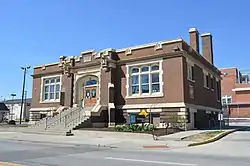 |
| Fort Benjamin Harrison Branch | 2021 | under construction | |
| Franklin Road Branch | 1969 | 5550 South Franklin Road, Indianapolis, Indiana 46239 |  |
| Garfield Park Branch | 1918 (relocated in 1965) | 2502 Shelby Street, Indianapolis, Indiana 46203 | 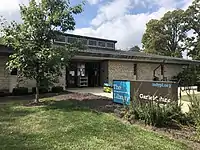 |
| Glendale Branch | 1930 (relocated in 2000) | Glendale Town Center 6101 North Keystone Avenue, Indianapolis, Indiana 46220 |
 |
| Haughville Branch | 1896 (relocated in 2003) | 2121 West Michigan Street, Indianapolis, Indiana 46222 |  |
| InfoZone Branch | 2000 | The Children's Museum of Indianapolis 3000 North Meridian Street, Indianapolis, Indiana 46208 |
|
| Irvington Branch | 1903 (relocated in 2001) | 5625 East Washington Street, Indianapolis, Indiana 46219 |  |
| Lawrence Branch | 1967 | 7898 North Hague Road, Indianapolis, Indiana 46256 | |
| Martindale–Brightwood Branch | 1901 (relocated in 2020) | 2434 North Sherman Drive, Indianapolis, Indiana 46218 |  |
| Michigan Road Branch | 2018 | 6201 Michigan Road, Indianapolis, Indiana 46268 |  |
| Nora Branch | 1971 | 8625 Guilford Avenue, Indianapolis, Indiana 46240 |  |
| Pike Branch | 1967 (relocated in 1986) | 6525 Zionsville Road, Indianapolis, Indiana 46268 |  |
| Southport Branch | 1967 | 2630 East Stop 11 Road, Indianapolis, Indiana 46227 |  |
| Spades Park Branch | 1912 | 1801 Nowland Avenue, Indianapolis, Indiana 46201 | 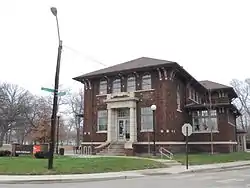 |
| Warren Branch | 1974 | 9701 East 21st Street, Indianapolis, Indiana 46229 |  |
| Wayne Branch | 1969 | 198 South Girls School Road, Indianapolis, Indiana 46231 |  |
| West Indianapolis Branch | 1897 (relocated in 1986) | 1216 South Kappes Street, Indianapolis, Indiana 46221 |  |
| West Perry Branch | 2021 | under construction |
Notes
References
- "2019 Annual Report" (PDF). Indianapolis Public Library. Retrieved August 7, 2020.
- "Work at the Library". Indianapolis Public Library. Retrieved August 7, 2020.
- Bodenhamer, David J., and Robert G. Barrows, eds. (1994). The Encyclopedia of Indianapolis. Bloomington and Indianapolis: Indiana University Press. pp. 789–791. ISBN 0-253-31222-1.CS1 maint: multiple names: authors list (link) CS1 maint: extra text: authors list (link)
- Butsch Freeland, Sharon (March 22, 2016). "HI Mailbag: Indianapolis Public Library". HistoricIndianapolis.com. Retrieved August 9, 2020.
- McLaughlin, Kathleen (May 5, 2011). "Next library CEO faces great expectations". Indianapolis Business Journal. Retrieved August 9, 2020.
- Shuey, Mickey (August 17, 2020). "Library planning to buy former school for new $10.2M Glendale branch". Indianapolis Business Journal. Retrieved August 17, 2020.
- Russell, John (August 14, 2020). "Methodist Hospital expansion exposes tax tensions". Indianapolis Business Journal. Retrieved August 16, 2020.
- Jarosz, Francesca (October 7, 2010). "Ailing library eyes new funding source". Indianapolis Business Journal. Retrieved August 10, 2020.
- McLaughlin, Kathleen (April 8, 2010). "Marion County library may close six branches". Indianapolis Business Journal. Retrieved August 9, 2020.
- "Library slashes hours, to close main branch on Thursdays". Indianapolis Business Journal. September 14, 2010. Retrieved August 9, 2020.
- McLaughlin, Kathleen (November 4, 2010). "Library cuts 37 employees in effort to reduce deficit". Indianapolis Business Journal. Retrieved August 10, 2020.
- "City-County Councilor Nytes named library CEO". Indianapolis Business Journal. October 17, 2014. Retrieved August 9, 2020.
- "Our Leadership". Indianapolis Public Library. Retrieved September 23, 2011.
- McLaughlin, Kathleen (October 17, 2014). "Library plans $59M in new branches, upgrades". Indianapolis Business Journal. Retrieved August 9, 2020.
- Warburton, Bob (December 14, 2014). "Indianapolis Approves $58 Million in Bonds for Libraries". Library Journal. Retrieved February 2, 2018.
- "Indy Library Board approves merger of Beech Grove Library". WISHTV.com. April 28, 2016. Retrieved April 26, 2016.
- "National Register Information System". National Register of Historic Places. National Park Service. March 13, 2009.
- "Indiana State Historic Architectural and Archaeological Research Database (SHAARD)" (Searchable database). Department of Natural Resources, Division of Historic Preservation and Archaeology. Retrieved 2016-08-01. Note: This includes Lawrence Downey (July 1975). "National Register of Historic Places Inventory Nomination Form: Central Library (Indianapolis-Marion County Public Library)" (PDF). Retrieved 2016-08-01. and accompanying photographs.
- Megan Fernandez (June 2010). "The Pillar: Evans Woollen". Indianapolis Monthly. Indianapolis, Indiana: 73. Retrieved December 18, 2017. See also: "Biographical" Sketch in Woollen, Molzan and Partners, Inc. Architectural Records, ca. 1912–2011. Indianapolis: Indiana Historical Society. 2017.
- Woollen, Molzan and Partners website project page Archived 2011-07-18 at the Wayback Machine
- Swiatek, Jeff (December 21, 2007). "Storybook ending?: Next chapter in Central Library saga could yield a commercial boom for surrounding area". The Indianapolis Star. Retrieved January 5, 2016.
- Central to Our History: Indianapolis Special Collections Room, n.d., brochure, Indianapolis, IN: Indianapolis-Marion County Public Library.
- Bahr, Sarah (October 23, 2017). "Indianapolis Public Library Debuts New Center For Black Literature And Culture". Indianapolis Monthly. Indianapolis: Emmis Communications. Retrieved August 7, 2020.
- Quinn, Samm (July 22, 2020). "City-County Council committee approves $5.3M bond for library upgrades". Indianapolis Business Journal. Retrieved August 10, 2020.
- "Indianapolis Central Library unveils LGBTQ+ exhibit". WRTV. Indianapolis. November 15, 2019. Retrieved August 7, 2020.
- Orr, Susan (February 11, 2020). "Deal between Indy Reads, library would relocate bookstore to Fountain Square". Indianapolis Business Journal. Retrieved August 10, 2020.
- "Locations & Hours". Indianapolis Public Library. Retrieved March 10, 2018.
- "Get a Library Card". Indianapolis Public Library. Retrieved August 7, 2020.
Further reading
- Berry, S.L. Stacks: A History of the Indianapolis-Marion County Public Library. Indianapolis: Indianapolis-Marion County Public Library Foundation, 2011.
- Downey, Lawrence J. A Live Thing in the Whole Town: The History of the Indianapolis-Marion County Public Library, 1873-1990. Indianapolis: Indianapolis-Marion County Public Library Foundation, 1991.
- Jean Preer (2013). "Counter Culture: The World as Viewed from Inside the Indianapolis Public Library, 1944–1956". In Christine Pawley; Louise S. Robbins (eds.). Libraries and the Reading Public in Twentieth-Century America. Print Culture History in Modern America. University of Wisconsin Press. ISBN 978-0299293239.
External links
| Wikimedia Commons has media related to Libraries in Indianapolis. |

